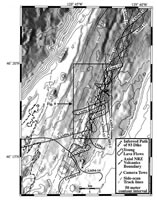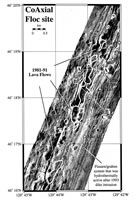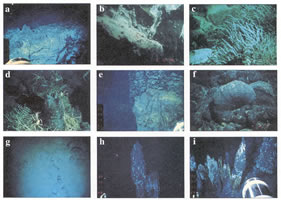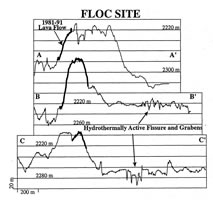U.S. Dept. of Commerce / NOAA / OAR / PMEL
/ Publications
Recent eruptions on the CoAxial segment of the Juan de Fuca Ridge:
Implications for mid-ocean ridge accretion processes
R. W. Embley,1 W. W. Chadwick,2 M. R. Perfit,3
M. C. Smith,3 and J. R. Delaney4
1Pacific Marine Environmental Laboratory, National Oceanic
and Atmospheric Administration, Hatfield Marine Science Center, Newport, Oregon
97365
2Cooperative Institute for Marine Resources Studies, Oregon State
University, Hatfield Marine Science Center, Newport, Oregon 97365
3Department of Geology, University of Florida, Gainesville, Florida,
32611
4School of Oceanography, University of Washington, Seattle, WA 98195
Journal of Geophysical Research, 105(B7),
16,501–16,525 (2000).
Copyright ©2000 by the American Geophysical Union. Further electronic distribution
is not allowed.
7. Floc Site
The July/August 1993 CTDT (conductivity, temperature, depth, light transmission)
profiles showed high light attenuation values in the plumes located around 46°18 N
and centered above the CoAxial neovolcanic zone in the middle of the axial valley
[Baker
et al., 1995; Embley
et al., 1995]. This area became known as the "Floc site" (Figures
1, 8, and 9).
It should be noted that at the latitude of the Floc site, almost all of the
epicenters in the 1993 T wave swarm are west of the CoAxial neovolcanic
zone. The Floc site is where a mismatch between the T wave locations
and seafloor geology becomes clear. A ROPOS dive at the Floc site in
1993 observed large white particles up to 200 m above the bottom and
"snowdrifts" of these flocculent particles on the seafloor (Plate
2h). After localizing the source area with the Scripps Deep-Tow system in
August [Spiess
and Hildebrand, 1993], Alvin dives in October 1993 documented
extensive diffuse venting along a fissure and graben system, including
some places where vent fluid was so laden with large white particles that the
sites became known as "snow blower" vents (Plate
2i) [Haymon
et al., 1993]. Taylor
and Wirsen [1997] propose that production of these particles is controlled
by direct excretion of filamentous sulfur from sulfur oxidizing bacteria. A
high production of sulfur-rich particles was produced at the 9°45–52
N
and centered above the CoAxial neovolcanic zone in the middle of the axial valley
[Baker
et al., 1995; Embley
et al., 1995]. This area became known as the "Floc site" (Figures
1, 8, and 9).
It should be noted that at the latitude of the Floc site, almost all of the
epicenters in the 1993 T wave swarm are west of the CoAxial neovolcanic
zone. The Floc site is where a mismatch between the T wave locations
and seafloor geology becomes clear. A ROPOS dive at the Floc site in
1993 observed large white particles up to 200 m above the bottom and
"snowdrifts" of these flocculent particles on the seafloor (Plate
2h). After localizing the source area with the Scripps Deep-Tow system in
August [Spiess
and Hildebrand, 1993], Alvin dives in October 1993 documented
extensive diffuse venting along a fissure and graben system, including
some places where vent fluid was so laden with large white particles that the
sites became known as "snow blower" vents (Plate
2i) [Haymon
et al., 1993]. Taylor
and Wirsen [1997] propose that production of these particles is controlled
by direct excretion of filamentous sulfur from sulfur oxidizing bacteria. A
high production of sulfur-rich particles was produced at the 9°45–52 N
East Pacific Rise site [Haymon
et al., 1993], and there is photographic evidence (Embley, unpublished
data, 1987) for a large particle accumulation on the seafloor following the
mid-1980s eruption at the north Cleft site [Embley
and Chadwick, 1994]. Hyperthermophilic Archaea (with optimal
growth ranges of 90°C) were cultured from vent fluids sampled from the
Floc site in October 1993 (but not subsequently), strongly implying the presence
of a viable, substantive subsurface microbial biomass at this site in the months
following the 1993 dike intrusion [Delaney
et al., 1998; Holden
et al., 1998].
N
East Pacific Rise site [Haymon
et al., 1993], and there is photographic evidence (Embley, unpublished
data, 1987) for a large particle accumulation on the seafloor following the
mid-1980s eruption at the north Cleft site [Embley
and Chadwick, 1994]. Hyperthermophilic Archaea (with optimal
growth ranges of 90°C) were cultured from vent fluids sampled from the
Floc site in October 1993 (but not subsequently), strongly implying the presence
of a viable, substantive subsurface microbial biomass at this site in the months
following the 1993 dike intrusion [Delaney
et al., 1998; Holden
et al., 1998].

Figure 8. Bathymetric map of central CoAxial segment, including the Floc
site. See Figure 5 caption for details.

Figure 9. AMS-60 side-scan mosaic of fissure swarm (solid white lines) and
1981–1991 lava flows (white outline) at the Floc site. Boundaries of young
lavas, extent of venting along fissure, and vent sites (e.g., Mkr 18) determined
from camera tows (Figure 8) and Alvin dives.
Location of map shown by box in Figure 8. Dotted
lines are depth cross-sections shown in Figure 10.
Observations from the Alvin dives and camera tows presented here and
from the plume surveys [Baker
et al., 1998] show that diffuse venting was occurring over >5 km along
strike from 46°16 to 46°19
to 46°19 N
(between Mkr 18 and Mkr 5 on Figure 9). Alvin
dives in the fall of 1993 observed only bacterial mats at these vent sites (Plates
2i and 3a), but subsequent dives in 1994
and 1995 to the same marked sites documented a rapidly evolving macrofaunal
community [Tunnicliffe
et al., 1997] (Plates 3b and 3c). By
1995, visible venting had declined to just a few isolated sites, notably at
the Huge Diffuse Vent (HDV) and marker 18 sites (Figure
9) and by 1996, observations (using ROPOS) of extensive predation
by crabs marked the rapid decline in the macrofaunal communities at the HDV
site (V. Tunnicliffe, personal communication, 1996) (Plate
3d). Time series observations of hydrothermal plumes for the same period
also show a rapid decline. By 1996, heat and particle content above the Floc
and Flow sites had returned nearly to background levels [Baker
et al., 1998]. These observations are consistent with the interpretation
that the 1993 dike intruded close to the surface beneath the Floc site but by
1996 had cooled to the point that it was no longer producing enough H
N
(between Mkr 18 and Mkr 5 on Figure 9). Alvin
dives in the fall of 1993 observed only bacterial mats at these vent sites (Plates
2i and 3a), but subsequent dives in 1994
and 1995 to the same marked sites documented a rapidly evolving macrofaunal
community [Tunnicliffe
et al., 1997] (Plates 3b and 3c). By
1995, visible venting had declined to just a few isolated sites, notably at
the Huge Diffuse Vent (HDV) and marker 18 sites (Figure
9) and by 1996, observations (using ROPOS) of extensive predation
by crabs marked the rapid decline in the macrofaunal communities at the HDV
site (V. Tunnicliffe, personal communication, 1996) (Plate
3d). Time series observations of hydrothermal plumes for the same period
also show a rapid decline. By 1996, heat and particle content above the Floc
and Flow sites had returned nearly to background levels [Baker
et al., 1998]. These observations are consistent with the interpretation
that the 1993 dike intruded close to the surface beneath the Floc site but by
1996 had cooled to the point that it was no longer producing enough H S
flux to support chemosynthesis at the seafloor/rock interface. The rapid contraction
of hydrothermal/biological sites above a dike intrusion was also observed at
the Cleft segment following its mid-1980s eruption [Embley
and Chadwick, 1994; Embley
et al., 1994].
S
flux to support chemosynthesis at the seafloor/rock interface. The rapid contraction
of hydrothermal/biological sites above a dike intrusion was also observed at
the Cleft segment following its mid-1980s eruption [Embley
and Chadwick, 1994; Embley
et al., 1994].

Plate 3. A series of 35-mm photographs from ROPOS, Alvin , and towed camera
of Floc and Source sites: (a) Bacterial mats coating wall of fissure at Floc
site (A-1993). (b) Nemerteans (each ~3 cm in length) on bacterial mats on wall
of fissure at southern Floc site near marker 18 (Figure
9) (A95). (c) Tubeworms (~0.3 m long) at HDV vent, Floc site (A95). (d)
Crabs feeding on remnants of tubeworm community at the HDV vent at the Floc
site (R96). (e) Young lavas (upper) coating wall of older lavas in fissure at
Floc site near marker 18 (A95). (f) The 1981–1991 pillow lavas at the Floc
site. Note small but distinct sediment pockets in these lavas (A95). Pillow
is ~1 m across. (g) Photo from USGS towed camera of sediment-covered lavas between
the AVNRZ and the CoAxial neovolcanic zone. Photo is ~5 m across. (h) Top (~2
m) of 7-m chimney ("Mongo") at Source site. (i) Small chimneys (~0.5–1.0
m high) at Source vent lining up on structure oblique to primary chimneys.
Structural control of the venting at the Floc site is revealed by side-scan
imagery, which shows a braided and anastomosing fracture system 100–200
m wide cutting through low-relief seafloor from about 46°16 N
to 46°19.5
N
to 46°19.5 N (Figures
9 and 10). This zone probably consists largely
of preexisting structures that were reactivated during the 1993 intrusion (in
contrast to the Flow site where the structures hosting active venting appeared
to be new [Chadwick
and Embley, 1998]). The southern part of the zone was apparently an
eruptive vent in the recent past; submersible observations showed extensive
drainback of young sheet flows between 46°17.5
N (Figures
9 and 10). This zone probably consists largely
of preexisting structures that were reactivated during the 1993 intrusion (in
contrast to the Flow site where the structures hosting active venting appeared
to be new [Chadwick
and Embley, 1998]). The southern part of the zone was apparently an
eruptive vent in the recent past; submersible observations showed extensive
drainback of young sheet flows between 46°17.5 N
and 46°18.5
N
and 46°18.5 N. An old sequence of
pillow lavas was observed to be partly "coated" with a veneer of younger sheet
flows characterized by "bathtub rings" (Plate 3e).
Such drainback features are characteristic of eruptive fissures observed (mostly)
on intermediate to fast portions of the MOR. An interesting aspect of the venting
at the Floc site was that while it was located within a zone that consists of
many individual structures, the venting at any particular location was always
localized along a single fissure or graben, usually the westernmost structure
in the swarm. Hydrothermal fluids vented from the floor, walls, and rims of
the structures.
N. An old sequence of
pillow lavas was observed to be partly "coated" with a veneer of younger sheet
flows characterized by "bathtub rings" (Plate 3e).
Such drainback features are characteristic of eruptive fissures observed (mostly)
on intermediate to fast portions of the MOR. An interesting aspect of the venting
at the Floc site was that while it was located within a zone that consists of
many individual structures, the venting at any particular location was always
localized along a single fissure or graben, usually the westernmost structure
in the swarm. Hydrothermal fluids vented from the floor, walls, and rims of
the structures.

Figure 10. Depth cross sections of Floc site. Locations shown in Figure
9.
Sohn
et al. [1998] located nine microearthquakes at the center of the CoAxial
axial valley between 46°13 N and 46°17
N and 46°17 N
during a 1-month deployment of an ocean bottom seismometer array in 1994, 1
year after the eruption. Sohn
et al. [1998] attribute this activity to post diking tectonic adjustments,
which is consistent with the geologic evidence presented here.
N
during a 1-month deployment of an ocean bottom seismometer array in 1994, 1
year after the eruption. Sohn
et al. [1998] attribute this activity to post diking tectonic adjustments,
which is consistent with the geologic evidence presented here.
Return to previous section or go to next
section
PMEL Outstanding Papers
PMEL Publications Search
PMEL Homepage
 N
and centered above the CoAxial neovolcanic zone in the middle of the axial valley
[Baker
et al., 1995; Embley
et al., 1995]. This area became known as the "Floc site" (Figures
1, 8, and 9).
It should be noted that at the latitude of the Floc site, almost all of the
epicenters in the 1993 T wave swarm are west of the CoAxial neovolcanic
zone. The Floc site is where a mismatch between the T wave locations
and seafloor geology becomes clear. A ROPOS dive at the Floc site in
1993 observed large white particles up to 200 m above the bottom and
"snowdrifts" of these flocculent particles on the seafloor (Plate
2h). After localizing the source area with the Scripps Deep-Tow system in
August [Spiess
and Hildebrand, 1993], Alvin dives in October 1993 documented
extensive diffuse venting along a fissure and graben system, including
some places where vent fluid was so laden with large white particles that the
sites became known as "snow blower" vents (Plate
2i) [Haymon
et al., 1993]. Taylor
and Wirsen [1997] propose that production of these particles is controlled
by direct excretion of filamentous sulfur from sulfur oxidizing bacteria. A
high production of sulfur-rich particles was produced at the 9°45–52
N
and centered above the CoAxial neovolcanic zone in the middle of the axial valley
[Baker
et al., 1995; Embley
et al., 1995]. This area became known as the "Floc site" (Figures
1, 8, and 9).
It should be noted that at the latitude of the Floc site, almost all of the
epicenters in the 1993 T wave swarm are west of the CoAxial neovolcanic
zone. The Floc site is where a mismatch between the T wave locations
and seafloor geology becomes clear. A ROPOS dive at the Floc site in
1993 observed large white particles up to 200 m above the bottom and
"snowdrifts" of these flocculent particles on the seafloor (Plate
2h). After localizing the source area with the Scripps Deep-Tow system in
August [Spiess
and Hildebrand, 1993], Alvin dives in October 1993 documented
extensive diffuse venting along a fissure and graben system, including
some places where vent fluid was so laden with large white particles that the
sites became known as "snow blower" vents (Plate
2i) [Haymon
et al., 1993]. Taylor
and Wirsen [1997] propose that production of these particles is controlled
by direct excretion of filamentous sulfur from sulfur oxidizing bacteria. A
high production of sulfur-rich particles was produced at the 9°45–52 N
East Pacific Rise site [Haymon
et al., 1993], and there is photographic evidence (Embley, unpublished
data, 1987) for a large particle accumulation on the seafloor following the
mid-1980s eruption at the north Cleft site [Embley
and Chadwick, 1994]. Hyperthermophilic Archaea (with optimal
growth ranges of 90°C) were cultured from vent fluids sampled from the
Floc site in October 1993 (but not subsequently), strongly implying the presence
of a viable, substantive subsurface microbial biomass at this site in the months
following the 1993 dike intrusion [Delaney
et al., 1998; Holden
et al., 1998].
N
East Pacific Rise site [Haymon
et al., 1993], and there is photographic evidence (Embley, unpublished
data, 1987) for a large particle accumulation on the seafloor following the
mid-1980s eruption at the north Cleft site [Embley
and Chadwick, 1994]. Hyperthermophilic Archaea (with optimal
growth ranges of 90°C) were cultured from vent fluids sampled from the
Floc site in October 1993 (but not subsequently), strongly implying the presence
of a viable, substantive subsurface microbial biomass at this site in the months
following the 1993 dike intrusion [Delaney
et al., 1998; Holden
et al., 1998].


 S
flux to support chemosynthesis at the seafloor/rock interface. The rapid contraction
of hydrothermal/biological sites above a dike intrusion was also observed at
the Cleft segment following its mid-1980s eruption [
S
flux to support chemosynthesis at the seafloor/rock interface. The rapid contraction
of hydrothermal/biological sites above a dike intrusion was also observed at
the Cleft segment following its mid-1980s eruption [
